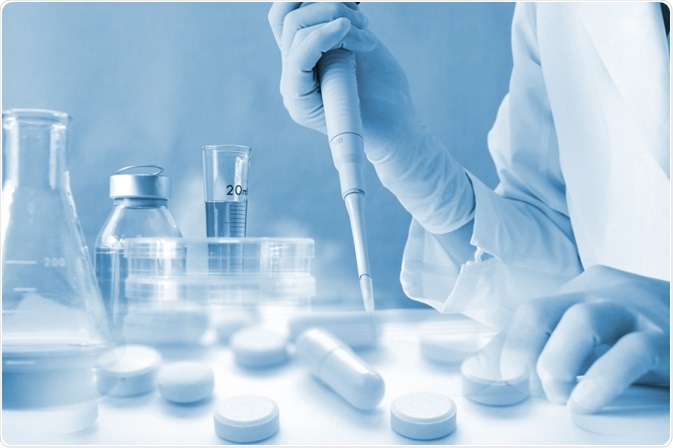Scientific research in areas such as drug development and the food industry requires rigorous testing of new chemical compounds to determine their safety for the open market and human use.
One vital test is on a substance’s potential genotoxic effects. This article will provide an overview of the subject and why it is so important that this is tested.

Image Credit: CA-SSIS/Shutterstock.com
What is Genotoxicity?
In genetics, genotoxicity is a term that describes the properties of chemicals pertaining to their ability to cause damage to genetic material. This can lead to mutations and, possibly, various types of cancer.
Genotoxicity is similar to and can be confused with mutagenicity except that all mutagenic substances are genotoxic, whereas, conversely, not all genotoxic substances are mutagenic.
Genotoxicity can lead to indirect or direct effects on the DNA including mutation induction, mistimed event activation, and direct DNA damage which leads to mutations. It causes direct, heritable changes that can be passed to future generations of cells.
Whereas this would normally be mitigated by the organism via DNA repair or the process of apoptosis (controlled cell death) the damage may not always be fixed, which leads to mutagenesis.
Genotoxins can include chemical substances and radiation. Depending on their effects within an organism, genotoxins can be categorized thusly:
- Carcinogens (cancer-causing agents)
- Mutagens (mutation-causing agents)
- Teratogens (birth defect causing agents)
There are two different effects of a genotoxic agent in a eukaryotic organism depending on which type of cell is affected. In somatic cells, genetic damage may lead to malignancy (cancer) whereas in germ cells heritable mutations may occur leading to birth defects.
Common damage caused by genotoxic agents includes single and double-strand breaks in DNA, structural and numerical chromosomal aberrations, point mutations, and loss of excision repair. Knowledge of the potential effects of the chemical is vital if public safety is to be assured.
Genotoxicity Testing: How Does it Work?
Evaluation of the genotoxicity effects of various materials for use as drug components is vital. For example, chromium, which is a transition metal, can cause DNA lesions which can lead to carcinogenesis.
Pyrrolizidine alkaloids are substances that occur in plant species but are toxic to animals including humans. Almost half of all PAs are classed as genotoxic and many are tumorigenic. Many chemicals have the potential to be genotoxic, and by extension, mutagenic.
Many different techniques can be used to test for the genotoxicity of a substance. These can either be in-vivo or in-vitro tests and include:
- Ames Assay – This commonly used technique uses multiple bacterial strains of Salmonella typhimurium to compare different genetic changes and assess the genotoxicity of a substance. The bacteria are incubated with histidine, which they need but cannot produce. Any strains which are left alive at the end of the test will, therefore, have mutated to synthesize histidine, which indicates that the chemical is potentially genotoxic. This technique is useful for identifying frameshift and point mutations.
- Comet Assay (Single-cell gel electrophoresis) – Another commonly used technique that measures DNA strand breaks in cells. Cells are embedded in agarose and are lysed with detergents and high salt. Comet-like structures are formed (hence the name) with damaged DNA strands containing double-strand breaks migrating toward the anode. This technique is advantageous as it can detect low levels of DNA damage and is a relatively simple and cheap procedure that produces quick results. However, a comet assay does not reveal the underlying mechanism for the genotoxic effect of the chemical.
- Micronucleus Test (MN) – This is a toxicological technique that is widely recognized as one of the most reliable and successful assays for genotoxic studies. A micronucleus is an erratic nucleus containing chromosomal fragments that are formed during the anaphase of mitosis or meiosis during cell replication. By studying the number of micronuclei produced in cells that have been exposed to the chemical under analysis, potential genotoxic and mutagenic properties can be evaluated.
Many genotoxicity studies use multiple assaying methods in conjunction with each other to build up a complete picture of the genotoxic potential of a chemical substance.
Thalidomide: An Example of the Need for Rigorous Genotoxicity Testing
Testing for the potential adverse effects of new and novel drugs is vitally important to ensure public safety. One famous historical case which could have been avoided if proper genotoxic assaying had been performed is that of thalidomide, a sedative drug discovered in the 1950s which was prescribed to pregnant women to relieve nausea but caused severe fetal abnormalities including limb defects and the absence of normal openings of the gastrointestinal tract in thousands of children worldwide.
Whilst the chapter was a tragic one, it led to the adoption of more rigorous testing procedures and a slew of regulations for the pharmaceutical industry.
This reinforces the need for such testing to ensure public safety when a new drug is released onto the market and proper screening for genotoxic properties of chemicals that may be released for use in various industries.
Sources
- Hayashi M. (2016). The micronucleus test-most widely used in vivo genotoxicity test. Genes and environment: the official journal of the Japanese Environmental Mutagen Society, 38, 18. https://doi.org/10.1186/s41021-016-0044-x genesenvironment.biomedcentral.com/articles/10.1186/s41021-016-0044-x
- Collins, A.R. The comet assay for DNA damage and repair. Mol Biotechnol 26, 249 (2004). https://doi.org/10.1385/MB:26:3:249 https://www.ncbi.nlm.nih.gov/pubmed/15004294
- Kim, H. R., Park, Y. J., Shin, D. Y., Oh, S. M., & Chung, K. H. (2013). Appropriate in vitro methods for genotoxicity testing of silver nanoparticles. Environmental health and toxicology, 28, e2013003. https://doi.org/10.5620/eht.2013.28.e2013003 https://www.ncbi.nlm.nih.gov/pmc/articles/PMC3577117/
- Saks, M. Upreti, S., Rajendra, S.V.,& Dang R. (2017). Genotoxicity: Mechanisms, Testing Guidelines and Methods Glob J Pharmaceu Sci 1(5): GJPPS.MS.ID.555575 (2017) https://juniperpublishers.com/gjpps/pdf/GJPPS.MS.ID.555575.pdf
- Encyclopedia Britannica: Thalidomide https://www.britannica.com/science/thalidomide
Further Reading
Last Updated: Jul 18, 2023